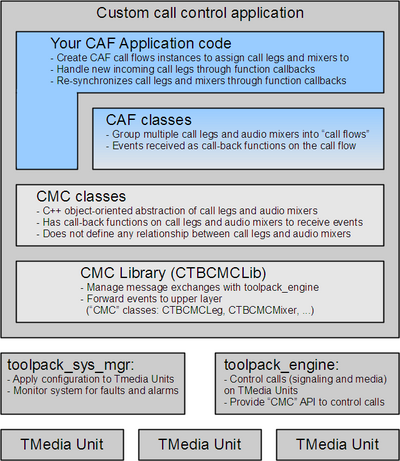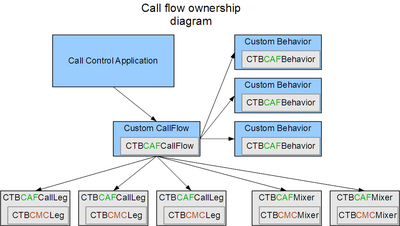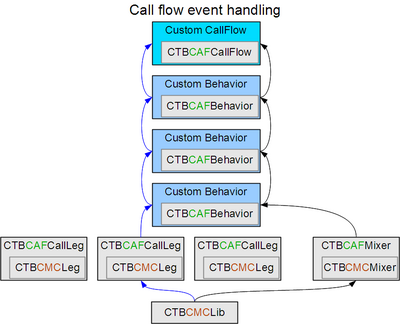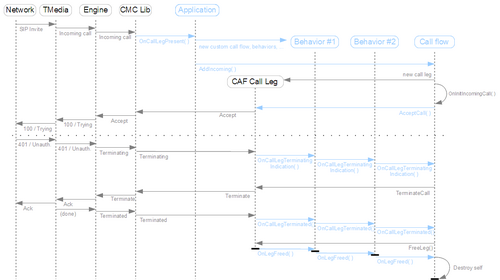CAF: Working With Caf Call Legs
Overview of CAF layer
TelcoBridges provides multiple API layers for managing calls. The current page refers the the CAF API layer.
Overview of CAF call architecture
CAF Call leg (CTBCAFCallLeg):
The CTBCAFCallLeg (based on CTBCMCLeg base class) is the representation of communication with one peer, either through one protocol (SS7, ISDN, SIP, CAS) or media-only.
CTBCAFCallLeg objects can be created either after the toolpack_engine has notified the CAF application that a new call has been received, or else when the CAF application asks toolpack_engine to create a new outgoing call. When creating a new outgoing call, attributes are provided to indicate toolpack_engine which NAP to make the call to (which also defines the signaling protocol), which calling/called numbers to use, etc.
From the C++ point of view, the CTBCMCLeg contains most of the APIs require to manipulate call legs, while the CTBCAFCallLeg class is providing the interface to attach call legs to a parent CTBCAFCallFlow object
CAF Mixer (CTBCAFMixer):
CAF Call Legs (CTBCAFCallLeg) have a built-in function to join with another leg, making audio flow from one leg to the other directly.
However, when it is required to mix audio from multiple call legs or sources (building conferences for example), then the CTBCAFMixer object is used.
The CTBCAFMixer (based on CTBCMCMixer base class) is the representation of a DSP resource used to mix audio from different sources (call legs, stream server, or other mixers).
From the C++ point of view, the CTBCMCMixer contains most of the APIs require to manipulate mixers, while the CTBCAFMixer class is providing the interface to attach mixers to a parent CTBCAFCallFlow object.
The CTBCAFMixer object can be used for:
- Conferences
- Background music playing on a call
- Recording both call legs of a call into one mixed audio file
- etc.
See more information on mixers here: [Audio Mixers]
CAF Call Flow (CTBCAFCallFlow):
The CTBCAFCallFlow base class contains one or multiple CTBCAFCallLeg objects, and optionally one or multiple CTBCAFMixer objects. The role of the CTBCAFCallFlow object is to implement a call flow that involves actions on legs and mixers that have a relation with each other.
CAF Call Bridge (CTBCAFBridge, based on CTBCAFCallFlow):
A typical implementation of a call flow is the CTBCAFBridge class (based on the CTBCAFCallFlow base class). This class is designed to - Receive an incoming call - Make a corresponding outgoing call - Join them together - Terminate both of them when one leg hangups.
CAF Call Behavior (CTBCAFCallBehavior):
Behaviors CTBCAFCallBehavior can be attached to a call flow (CTBCAFCallFlow). Their role is to modify the basic call flow, decorating it with optional functionality (CDR logging, FAX detection, Ring tone playback, etc.)
In order to implement their functionality, behavior objects, like their parent call flow object, receive events from all call legs and mixers of the call flow. They can also manipulate call legs and mixers.
Performing actions on call legs and mixers
Actions on call legs
The call flow (and it's behaviors) can perform various actions on each of it's call legs. Here is a list of the actions available on the CTBCAFCallLeg objects (please refer to the header file CTBCMCLeg.hpp for more information on each of these functions):
Actions on mixers
The call flow (and it's behaviors) can perform various actions on each of it's mixers. Here is a list of the actions available on the CTBCAFMixer objects (please refer to the header file CTBCMCMixer.hpp for more information on each of these functions):
Receiving events from call legs and mixers
Events received from call legs by the CTBCAFCallFlow object
The call flow object (as well as all it's behaviors) receive the following events from it's call legs (please refer to the header file ITBCAFCallFlow.hpp for more information on each of these functions):
[Call flow events from it's call legs]
Events received from mixers by the CTBCAFCallFlow object
The call flow object (as well as all it's behaviors) receive the following events from it's mixers (please refer to the header file ITBCAFCallFlowMixer.hpp for more information on each of these functions):
[Call flow events from it's mixers]
Events behavior chain
All the events describe above are called consecutively on each behavior attached to the call flow, and ultimately, called on the call flow itself.
Each behavior in the chain can
- Pass the event to the next behavior in the chain
- Consume the event so other behaviors in the chain and the call flow are unaware that this event occurred
The CTBCAFCallBehavior default implementation is to forward the event to the next event in the chain.
When you implement your own behaviors, you can override only a couple of events (like OnCallLegAnswered() for example) to perform specific tasks, and leave all other events to the base class, so you don't have to write a lot of code to create a new behavior.
Example call flows
Example call flow where an incoming call is received, accepted, then terminated from network side:
Example conference call flow with two incoming call legs, one outgoing call leg, and one audio mixer:
Creating the CTBCAFCallFlow object, it's legs and mixers
Steps to create a new call flow are:
- Create a new object (using a class derived from CTBCAFCallFlow class)
- Attach behaviors to the call flow
- Add attributes of incoming and outgoing legs to create
- Add attributes for mixers to create
- Tell the call flow object to initialize itself, and create the call legs and mixers as requested
Here is a (over-simplified) example:
ITBCAFCallFlow* pCallFlow; ITBCAFCallFlow* pParentCallOrBehavior; // Create the call flow object (here using the CTBCAFBridge class, based on CTBCAFCallFlow) pCallFlow = tbnew CTBCAFBridge( 0, this); // Optionally, attach behaviors pParentCallOrBehavior = pCallFlow; pParentCallOrBehavior = tbnew CTBCAFCallBehaviorBusyTone( pParentCallOrBehavior, ... ); pParentCallOrBehavior = tbnew CTBCAFCallBehaviorBridgeCdr( pParentCallOrBehavior, ... ); // Add an incoming call leg to that call flow (CTBCAFCallLeg object will get created based on provided attributes) pCallFlow->AddIncoming( in_LegId, ptrIncomingLegAttribute, ptrIncomingLegProtocolAttributes, ptrAcceptCallProtAttribute ); // Add an outgoing call leg pCallFlow->AddOutgoing( ptrOutgoingLegAttribute, ptrOutgoingLegProtocolAttributes ); // Create an audio mixer pCallFlow->MixerCreate( ptrMixerAttribute ); // Initialize the call (this actually creates the call legs) pCallFlow->InitCall( &pCallFlow );
During the call flow (upon reception of an event on a call leg for example), more actions can be taken. For example:
MyCallBehavior::OnCallLegAnswered()
{
// Ask to detect FAX tones
CTBCMC_EVENT_ATTRIBUTE Event;
Event.AddToneString( "telcofax/eof" );
GetIncomingActiveLeg()->StartEventCollection( in_EventMask, NULL, TBX_FALSE /* Don't suppress tones */ );
// Call base class to forward event to next behavior
CTBCAFBehavior::OnCallLegAnswered();
}
During the call flow (upon reception of an event on a mixer for example), more actions can be taken. For example:
MyCallBehavior::OnMixerCreated()
{
// Immediately add call legs to the mixer
GetFirstMixer()->MixerJoin( GetIncomingActiveLeg().Get(), ptrJoinAttributes );
GetFirstMixer()->MixerJoin( GetOutgoingActiveLeg().Get(), ptrJoinAttributes );
// Answer the incoming leg
GetIncomingActiveLeg()->AnswerCall();
// Play background music on the conference
GetFirstMixer()->MixerPlayStream( PlayAttr );
// Call base class to forward event to next behavior
CTBCAFBehavior::OnMixerCreated();
}
For a more complete code example, please refer to the simple_call application, in file CTBS2GWSimpleCall.cpp file, or here:
Constructing leg attributes
Incoming call leg attributes
To create the incoming call leg, the following information is required:
- Smart pointer to incoming call leg attributes, received from toolpack_engine through OnCallLegPresent().
ptrIncomingLegAttribute = tbnew CTBCMC_CALL_LEG_ATTRIBUTE( *(in_CallLegAttribute.GetCallLegAttribute()) );
- Smart pointer to incoming call leg attributes, received from toolpack_engine through OnCallLegPresent().
ptrIncomingLegProtocolAttributes = tbnew CTBCMC_PROTOCOL_ATTRIBUTE( in_ProtocolAttribute, TBX_TRUE );
- Smart pointer to empty protocol attributes that Behaviors can fill, and that will be used when accepting the call
Outgoing call leg attributes
To create the outgoing call leg, the following information is required:
- Smart pointer to outgoing call leg attributes to use to create the call, generally derived from the incoming call attributes
ptrOutgoingLegAttribute = tbnew CTBCMC_CALL_LEG_ATTRIBUTE(); ptrOutgoingLegAttribute->CopyLegAttributeFrom( *(ptrIncomingLegAttribute.Get()) );
- Smart pointer to empty protocol attributes that Behaviors can fill, and that will be used when creating the outgoing call (SIP invite, ISUP IAM, ISDN Setup, etc.)
Mixer attributes
To create the mixer, the following information is required:
- Smart pointer to mixer attributes to use to create the mixer
ptrMixerAttribute = tbnew CTBCMC_MIXER_ATTRIBUTE(); ptrMixerAttribute->SomeParameter = SomeValue;
Call leg initialization callbacks
All behaviors attached to the call flow will be notified of the creation of new call legs through callback OnInitIncomingCallLeg or OnInitOutgoingCallLeg.
OnInitIncomingCallLeg()
In this callback, each behavior may consult the incoming call attributes or protocol attributes, and can modify the protocol attributes that will be used to accept the call (actually providing protocol-specific information, like SS7 IEs, or SIP headers).
OnInitOutgoingCallLeg()
In this callback, each behavior can modify the protocol attributes that will be used to create the call (actually providing protocol-specific information, like SS7 IEs, or SIP headers that will be used in the initial signaling message, as SIP Invite, ISUP IAM, or ISDN Setup).
OnMixerInit()
In this callback, each behavior can modify the mixer attributes that will be used to create the mixer.
Destruction the CTBCAFCallFlow object, it's legs and mixers
Self-destructing call legs, mixers, behaviors, and call flow
The CTBCAFCallFlow object contains smart pointers to it's call legs and mixers. Destruction of these will thus occur automatically when the last smart pointer reference is removed (that last reference can be either the smart pointer reference in the CTBCAFCallFlow object, or anywhere else in the application).
Upon destruction of the last call leg or last mixer (when no more leg or mixer are in the call flow), the objects based on CTBCAFCallFlow or CTBCAFCallBehavior will delete themselves automatically, by calling the attached "free listener" (that was provided in the constructor of the call flow object).
Call leg termination callbacks and actions
OnCallLegTerminatingIndication()
This callback means that toolpack_engine has received a termination request from a call leg (SIP Bye, ISUP REL, for example). A typical use of that event is to call TerminateCall() on both incoming and outgoing legs of a call flow, to hangup both sides.
TerminateCall()
This function is used for the application to request the termination of a call leg. It is also used to confirm that the application is done with a call leg, after OnCallLegTerminatingIndication() event was received (in that case, TerminateCall can be called within the event callback, or later if the application has some more asynchronous cleanup to do).
OnCallLegTerminated()
This callback confirms that toolpack_engine has finished closing the data path and signaling for this call leg. It will also be called when a leg is destroyed because of a lost of communication with toolpack_engine (restart, network failure, crash).
FreeLeg()
It is MANDATORY that this function is called for each call leg after OnCallLegTerminated().
It's up to the application to call the function immediately (within OnCallLegTerminated() for example) or later after doing some more job (like asynchronous database updates, for example)
OnLegFreed()
This callback confirms that the leg is being freed.
It's the last chance for a call flow or a behavior to release things related to a call leg, like canceling timers for example.
- Important note: Behaviors that implement that function MUST, as the LAST line of their function, call the base class' CTBCAFCallBehavior::OnLegFreed. Not calling base class' function will cause the call to leak. Calling that before the last line of the function will cause crash, as the Behavior object could destroy itself within that function upon destruction of the last leg/mixer of the call.
Mixer termination callbacks and actions
MixerTerminate()
This function is used for the application to request the termination of a mixer.
OnMixerTerminated()
This callback confirms that toolpack_engine has finished destroying resources related to this mixer. It will also be called when a leg is destroyed because of a lost of communication with toolpack_engine (restart, network failure, crash).
FreeMixer()
It is MANDATORY that this function is called for each mixer after OnMixerTerminated().
It's up to the application to call the function immediately (within OnMixerTerminated() for example) or later after doing some more job (like asynchronous database updates, for example)
OnMixerFreed()
This callback confirms that the mixer is being freed.
It's the last chance for a call flow or a behavior to release things related to a mixer, like canceling timers for example.
- Important note: Behaviors that implement that function MUST, as the LAST line of their function, call the base class' CTBCAFCallBehavior::OnMixerFreed. Not calling base class' function will cause the mixer and call to leak. Calling that before the last line of the function will cause crash, as the Behavior object could destroy itself within that function upon destruction of the last leg/mixer of the call.
Re-synchronizing with toolpack_engine
There are a couple of cases where a CAF application needs to re-synchronize with toolpack_engine:
- The CAF application was restarted
- The toolpack_engine was restarted
- Network connection between CAF application and toolpack_engine was momentarily down
When communication with toolpack_engine is lost, all call legs and mixers are notified of the disconnection through OnSyncLost() and OnMixerSyncLost. However, they are not immediately destroyed. They are kept in the CAF framework for 10 seconds waiting for the engine (or backup engine) to reconnect. After 10 seconds, legs and mixers are terminated in the CAF framwork. This does not mean, however, that they are terminated in the toolpack_engine. Upon reconnection with engine, legs and mixers still present in the engine will be sent back to the CAF application through OnCallLegSync() and OnMixerSync().
Possible scenarios for a leg are thus:
- Engine is reconnected within 10 seconds -> Some legs/mixers no more exist in toolpack_engine, and will be notified by OnCallLegTerminated() / OnMixerTerminated(). Legs/mixers that are still valid are notified with OnLinkSync() / OnMixerSync().
- Engine has been disconnected for more than 10 seconds -> CAF framework will terminate call legs/mixers, and notify them through OnCallLegTerminated() / OnMixerTerminated()
- Engine is reconnected after a >10 seconds disconnection period -> Call legs/mixers that are still available in toolpack_engine are pushed back to CAF application through OnCallLegSync(), OnLinkSync() and OnMixerSync()
Re-synchronization sequence
In all the cases above, the re-synchronization mechanism involves the following steps:
=> Communication lost with toolpack_engine
- OnCmcLibNotReady() (CAF application callback): Indicates that communication with toolpack_engine has been interrupted. It will not be possible to perform actions (play file, ask for digit collection) on call legs/mixers until toolpack_engine is ready again (OnCmcLibReady).
- OnSyncLost() (CAF call flow and behavior callback): Same meaning as OnCmcLibNotReady(), passed to each call leg contexts individually.
- OnMixerSyncLost() (CAF call flow and behavior callback): Same meaning as OnCmcLibNotReady(), passed to each call mixer contexts individually.
=> Communication re-established with toolpack_engine
- OnCallLegSync() (CAF application callback): Indicates that the toolpack_engine knows about a call leg that does not exist in the CAF application.
- OnLinkSync() (CAF application callback): Indicates that the toolpack_engine knows about a link between two call legs (legs are joined, audio is flowing from one to the other directly).
- OnMixerSync() (CAF application callback): Indicates that the toolpack_engine knows about a mixer that does not exist in the CAF application.
- OnCmcLibReady() (CAF application callback): Indicates that communication with toolpack_engine has been restored, and that all legs, links and mixers have been re-synchronized
- OnSyncDone() (CAF call flow and behavior callback): Indicates to a call leg (that previously received OnSyncLost()) that it is still present in the toolpack_engine, and ready to be controlled again.
- OnMixerSyncDone() (CAF call flow and behavior callback): Indicates to a mixer (that previously received OnMixerSyncLost()) that it is still present in the toolpack_engine, and ready to be controlled again.
- OnCallLegTerminated() (CAF call flow and behavior callback): When this function is called with Reason TBCMC_CALL_REASON_CODE_TOOLPACK_SYNC_DROP, it indicates that this call leg is no more present in toolpack_engine after re-synchronizing, and must thus be freed in the CAF application too.
- OnMixerTerminated() (CAF call flow and behavior callback): When this function is called, it indicates that this mixer is no more present in toolpack_engine after re-synchronizing, and must thus be freed in the CAF application too.
Rebuilding new legs, mixers and call flow objects
When an application receives OnCallLegSync(), it must take the decision to either keep the call leg (create a CTBCAFCallLeg object) or refuse it (tell toolpack_engine that we don't want to re-synchronize it, and that it must be terminated).
When an application receives OnMixerSync(), it must take the decision to either keep the mixer (create a CTBCAFMixer object) or refuse it (tell toolpack_engine that we don't want to re-synchronize it, and that it must be terminated).
Dropping re-synchronized legs
The static helper function CTBCMCLeg::RefuseLeg() has been provided by the class CTBCMCLeg to terminate re-synchronized call legs without having to worry about creating any object. An application that wants to refuse a re-synchronized leg should call it.
Dropping re-synchronized links
The static helper function CTBCMCLeg::RefuseLink() has been provided by the class CTBCMCLeg to terminate re-synchronized links without having to worry about creating any object. An application that wants to refuse a re-synchronized link should call it.
Dropping re-synchronized mixers
The static helper function CTBCMCMixer::RefuseMixer() has been provided by the class CTBCMCMixer to terminate re-synchronized mixer without having to worry about creating any object. An application that wants to refuse a re-synchronized mixer should call it.
Keeping re-synchronized legs that are part of a link or a mixer
The helper class CTBCAFCallLegResync is provided to help creating CTBCAFCallLeg objects for re-synchronized legs, and later retrieve them and attach them to a CTBCAFCallFlow parent, upon OnLinkSync() or OnMixerSync:
Upon OnLegSync(), legs should be allocated inside the class CTBCAFCallLegResync using function AllocateCallLeg(). Legs don't yet need to be attached to a parent CTBCAFCallFlow, that's normally done upon OnLinkSync() or OnMixerSync().
Upon OnLinkSync(), both linked call legs must be retrieved from the CTBCAFCallLegResync (using functions FindCallLeg() and RemoveCallLeg()), then added to a CTBCAFCallFlow object that will resume the call flow of these two joined call legs.
Upon OnMixerSync(), a new CTBCAFMixer object must be allocated, and all call legs from that mixer must be retrieved from the CTBCAFCallLegResync object (using functions FindCallLeg() and RemoveCallLeg()). The allocated mixer and found legs must then be assigned to a CTBCAFCallFlow object that will resume the call flow of these legs joined to a mixer.
Finally, upon OnCmcLibReady(), the application can destroy the CTBCAFCallLegResync object, which will take care of refusing (dropping) all call legs that it still references (that have not been removed by CTBCAFCallLegResync::RemoveCallLeg)
Simplified example code:
TBX_VOID CTBMyApp::OnCallLegSync
(
IN TBCMC_LEG_ID in_LegId,
IN CTBCMC_CALL_LEG_ATTRIBUTE_COMMON& in_CallLegAttribute
)
{
// Upon first re-synchronized leg, allocate utility class to contain re-synchronized call legs
if( !mpCallLegResync )
{
mpCallLegResync = new TBCAF::CTBCAFCallLegResync( MY_APP_MAX_CALLS );
}
// Re-create a CTBCAFCallLeg object for this re-synchronized leg
mpCallLegResync->AllocateCallLeg
(
NULL, // Not yet bound to a parent call flow
in_LegId, // Use the leg Id of this re-synchronized call leg
in_CallLegAttribute, // Store the attributes of this re-synchronized call leg
this, // Until it has a parent call flow, set ourself as
TBCMC_MSG_CALL_LEG_STATE_ACTIVE // Consider this call leg as active (answered)
// since only active calls can be re-synchronized
);
}
TBX_VOID CTBMyApp::OnLinkSync
(
IN TBCMC_LINK_ID in_LinkId,
IN TBCMC_LEG_ID in_SrcLegId,
IN TBCMC_LEG_ID in_DstLegId,
IN CTBCMC_JOIN_ATTRIBUTE & in_JoinAttribute
)
{
// Find both call legs in the re-sync utility mpCallLegResync
PTRCTBCAFCallLeg ptrSrcLeg = mpCallLegResync->RemoveCallLeg( in_SrcLegId );
PTRCTBCAFCallLeg ptrDstLeg = mpCallLegResync->RemoveCallLeg( in_DstLegId );
// Allocate a new call flow
PITBCAFCallFlow pMyCallFlow = tbnew CTBCAFMyCallFlow
(
this, // Set current application as free listener for my call flow
in_LinkId, // Id of the link between these two joined legs
in_JoinAttribute, // Attributes of the link between these two joined legs
ptrSrcLeg,
ptrDstLeg
);
// Re-attach behaviors to this call flow
pMyCallFlow = tbnew CTBCAFMyFirstBehavior( pMyCallFlow, ... );
pMyCallFlow = tbnew CTBCAFMySecondBehavior( pMyCallFlow, ... );
}
TBX_VOID CTBMyApp::OnCmcLibReady()
{
// Free all single call legs that remain
// Deleting mpCallLegResync will automatically reject legs still in that object
delete mpCallLegResync;
mpCallLegResync = NULL;
}
TBX_VOID CTBMyApp::OnCmcLibNotReady()
{
// Free all single call legs that remain
// Deleting mpCallLegResync will automatically reject legs still in that object
delete mpCallLegResync;
mpCallLegResync = NULL;
}
For a more complete code example, please refer to the simple_call application, in file CTBS2GWSimpleCall.cpp file.




